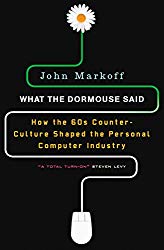“What The Dormouse Said” by John Markoff is an intruiging account of how the milieu of the counterculture movement in the San Francisco Bay Area of the 1960s shaped the evolution of the modern personal computer. In particular, it explores the effect of psychedelic drugs like LSD, anti-war protests, and the culture of sharing on the pioneers of this area of computing. In parts poignant, insightful, and funny, this book is a worthy complement to the two other great books on the history of personal computers — “Fire In The Valley” by Paul Freiberger & Mike Swaine, and “Hackers” by Steven Levy.
The 1960s seems to have been a heady (in more ways than one) time to be in the San Francisco Bay Area and more specifically in its Midpeninsula. People were trying to avoid being drafted (a pressing concern for a lot of the characters in this book) into the Vietnam War, staging protests against the war, “expanding” their minds by using pschedelic drugs, exploring “free love”, forming communes and “going back to the land”, etc.
On the other hand, the Vietnam War and the continuing Cold War with the Soviet Union, provided much of the initial funding for the influential duo of the Stanford Research Institute (SRI) and the Stanford Artificial Intelligence Laboratory (SAIL) that provided the impetus that took Silicon Valley far beyond the emerging semi-conductor industry into becoming a powerhouse of personal computer software and hardware.
This small book has a surprisingly large cast of characters (in my opinion a tad too many of them to keep track of), some famous in the computer industry and beyond, some not quite. The cast includes Doug Engelbart, John McCarthy, Alan Kay, Robert Taylor, Bill Duvall, Stewart Brand, Fred Moore, Ted Nelson, Bill Gates, Steve Jobs, Steven Wozniak, et al. Only some of the them, notably Doug Engelbart and Fred Moore are fleshed out in any detail; most others get short biographical sketches with varying levels of detail and sometimes just a passing mention (e.g. Steve Jobs and Donald Knuth).
In particular, this is the only decent account of the life of Doug Engelbart that I have read so far. He became famous for what has been called The Mother Of All Demos, a demo from 50 years ago (right down to the month) that showcased technological and human-interface breakthroughs so far ahead of their time that it took the rest of the computer industry many, many years (decades actually) to catch up with them. The book shows how he single-mindedly pursued his goal of augmenting human-intellect with computers at SRI, facing many obstacles along the way, and then dejectedly watched as it all petered out after the success of his demo, which turned out to be the pinnacle of his career.
The book pits AI in general, and John McCarthy at SAIL in particular, against the augmentation of human-intellect pursued by Doug Engelbart at SRI and Alan Kay at Xerox PARC, by giving it a goal of supplanting human-intellect by surpassing it. I am not sure all AI (and now ML) researchers will subscribe to this dichotomy that drives the intial narrative of the book. The other thing I found unconvincing in the book was the role of (supposedly mind-expanding) psychedelic drugs taken by many of the characters in the book (including even Doug Engelbart) — the author presents no evidence that this materially affected the course of the evolution of personal computers, so it is reduced to being an interesting (or shocking, depending on your viewpoint) aside.
The book seems to come to an abrupt end just as it started chronicling the infamous battle of Bill Gates with the hobbyist programmers of the Homebrew Computer Club over unauthorized copying of paper-tapes containing the Altair BASIC created by the nascent “Micro-Soft”. In my opinion, the book might have been better written as a bigger book containing fewer, but more fully sketched-out characters, supported by a tighter narrative.
Apart from the life and work of Doug Engelbart, there are quite a few things in this book that I have not read elsewhere. For example, the personal life of AI-pioneer and LISP-inventor John McCarthy, how the ARPANET (the precursor to the current Internet) really came into existence, the story of The Whole Earth Catalog before and after its short existence, etc. It is quite evident that the author has done a lot of research for this book and has talked to a lot of the key people during the course of this research. It is thus an invaluable resource for the students of computer history.
What I found really remarkable was the confluence of so many brilliant and creative minds over such a short period and inside such a small geographic area. What were the odds of this happening? In particular, Stanford comes across as a truly astonishing magnet for bringing together such people (which it continues to do to this day). Even when they were originally geographically disperse, some of these brilliant minds kept crossing each other’s paths and ended up influencing each other. Amazing.
